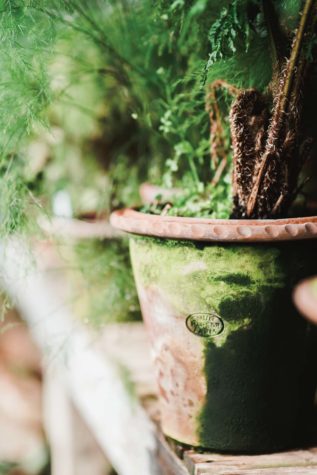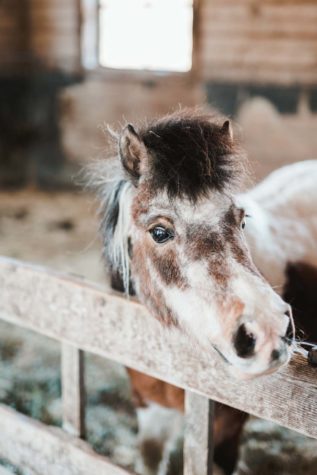Classic Gardens, Modern Business
From English gardens to Instagram, Snug Harbor Farm owner Tony Elliott finds inspiration in all the right places.
In the late 1990s, Tony Elliott was driving along Route 9 in Kennebunk when he spotted a “for sale” sign. It stood in front of a long and low farmhouse, a white clapboard structure with green doors and a big center gable with a weathervane perched upon it. The house, he learned, was built by a Dutch sea captain, who sold it to a farming couple named Belle and Clifford Jackson for a single dollar in the early years of the twentieth century. Jackson liked to do things the “old way.” Well into the 1970s, he was still planting his corn when the oak leaves reached the size of squirrels’ ears and using a team of horses to plow his fields. When Elliott stumbled upon the place, it had gone a bit to seed—Belle and Clifford were long gone, and their grandchildren hadn’t felt the passion for farming or, apparently, the same connection to the land. But Elliott, had always dreamed of having a farm of his own. So in 1998 he bought the deed from the Jackson family and began to settle in. He recognized the “authenticity of this place,” he says. “I’m not trying to fool anybody.”
While Elliott kept the clapboard and the big green barn door intact, he wasn’t averse to adding his own touches, building his own structures. Where there was once a humble vegetable-and-livestock farm, there’s now a bustling nursery, complete with six greenhous- es, a shop, a barn, raised garden beds, pastures, and a healthy animal population. There are chickens in the coop and canaries in the office building. There are rabbits in cages and horses milling about the fields. Snug Harbor Farm is many things, but at the most ba- sic level it’s the fulfillment of one man’s lifelong dream. “When I was a little kid, my parents would say to me, ‘What do you want for Christmas?’” he recalls, reciting an anecdote he’s told over a dozen times to reporters, longtime clients, and neighbors. “For Christmas, it was a farm set. For my birthday, it was a horse. One year it was something like a chia pet that would grow grass quickly.” He adds, “I’ve always gardened. Always.” Elliott’s parents both gardened, and when he headed off to college at Ohio State University he knew he was going to study something agriculture-adjacent. He ended up with a degree in agronomy, which he figured he could use to “travel the world and work wherever I wanted.” But after graduation he decided to go into landscape design and installation. Elliott moved to Maine, first settling in Ellsworth, where he had found a job in a greenhouse. Eventual- ly, he decided to move down to southern Maine and start a farm here. “I was always intrigued by English gardens,” he says, “but I got frustrated trying to do that here. One day I woke up and realized I should do New England gardens.” (New England gardens, Elliott explains, are heavy on the stone work and tend to be hardy and resilient.)
Over the decades, his gardening style has grown and evolved, as has his business. There was a period when everyone was into annuals, “getting hot and bothered by cosmos and Queen Sophia marigolds,” then came the perennials boom, followed by the wave of shrubs and trees. “Right now, I’m interested in the legacy you leave behind by planting trees,” he says. In addition to running the nursery and greenhouse, Elliott also works with a select group of clients on large-scale landscape design projects. “I take a lot of my cues from the architecture,” he says. “Even if you walk around this place, you’ll see that I design to reflect the buildings.” The buildings are made up of rooms and hallways, and Elliott mimics these lengthy forms with walkways and walls, hedges and garden beds. He also tries to create a slow flow from the more formal, manicured areas (located closer to the buildings on-site) to the wilderness by installing “transitional zones.” He says, “By the time you’re back into the wild, it’s seamless.” Elliott is currently working on a historic piece of property that had been cluttered over the years with many small gardens. “My job right now has been all about subtracting,” he says. “By the time I’m done, the hope is that it will look like it hasn’t been touched.” He wants every space he designs to feel timeless, authentic.
But Elliott’s classic and slightly old-school sensibility—as evidenced by the collection of botanical prints that hang in gold frames on his office wall—doesn’t preclude him from being an innovator. When asked how he stays abreast of fads in the gardening world (like the growing houseplant craze among millennials), Elliott responds, “What do you mean, stay abreast? We’re the trendsetters.” Elliott and his staff use Instagram to great effect. “We laugh about it; we’ll come up with an idea, push it online, and see it pop up in other places.” One example is his mushroom Christmas, the decor of which was based on the theory that the legend of Santa Claus was inspired by a psychedelic shaman from northern Finland. During Prelude (the Kennebunks’ annual preholiday festival), Elliott set up a teepee in the barn and invited guests to come by for tarot card readings. Elliott assures me that no drugs were consumed during the event, but he says the stunt did plant the notion of a fungal-infused holiday in the minds of many. “Next year, we started looking around and saw all these mushrooms popping up around Christmas,” he says.
Elliott was also an early proponent of the return to the terra cotta pot, another gardening trend that’s currently blossoming. “That’s a big part of who and what I am,” he says. “I now get pots manufactured for Snug Harbor Farm. It’s a material that has always been intriguing to me—the texture, the feel, the earthiness. It’s right there in the name.” A walk through his greenhouses shows ample use of both red clay and concrete planters, some of which even have the small, square Snug Harbor logo pressed into their sides. In one green- house I find rows upon rows of lavender bushes, shaped into whimsical lollipop topiaries, planted in modest terra cotta pots. In another greenhouse I find employees propagating succulents from the mother plants, laying down thick, fleshy leaves atop soil next to trays of miniature echeveria, sedum, haworthia, and aloe. Soon, a young bearded gardener explains, these baby plants will be transported to larger pots and sold, but right now they’re still being nursed. I take a picture of these uniform plants, marching along line by pale green line, and upload it to Instagram. Succulents are, as Elliott knows so well, really trendy right now.








